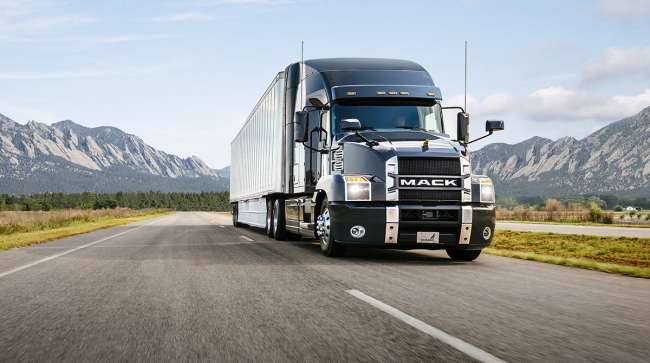Rear Axle Ratios Are Still Moving Downward

[Stay on top of transportation news: Get TTNews in your inbox.]
Downspeeding saves fuel, and with aerodynamics and tires continuing to improve, truck manufacturers are experimenting with still lower rear axle ratios.
I recently took a ride in a Mack Anthem with an experimental rear axle ratio of 2.31:1. Its operator is Joel Morrow, senior driver and head of research and development at Ploger Transportation of Norwalk, Ohio, a 100-tractor fleet. The miles we traveled along Interstate 20 in Mississippi included some rolling hills. The truck was quiet, there wasn’t any noticeable vibration, and the rig maintained speed quite effectively.
Morrow works with manufacturers to test advanced concepts, in this case with Rob Durling, lead engineer at Volvo Group Trucks Technology. His Anthem is a 6 × 2, and his engine is a Mack MP8-HE — Mack’s 13-liter offering with a turbocompounding system.
The HE engine supplies the same 1,850 pound-feet of torque as the standard MP8, the goal being similar torque output, but at a lower rpm. The resulting cruise rpm is only 1,060 rpm at 65 mph, as compared with the standard 65 mph cruise rpm of 1,150. Maximum torque is available down to 900 rpm.

Baxter
The standard ratio is 2.47:1, but Morrow has found the ultra-low 2.31:1 ratio works well, given the right operating technique, and it gives superb fuel economy even at speeds of 70 mph and above. He has managed up to 8.5 mpg at a legal 75 mph with light loads. The super-fast ratio also allows zero-fuel coasting down slight grades with the transmission in gear. Since the standard axle ratio won’t allow the truck to hold cruise speed on a slight downgrade without kicking the transmission out of gear and idling, this saves more fuel.
He handles hills by using the driver-controlled shift function of the mDrive to kick the transmission back into 11th gear just before losing any speed. The rig rolls right up most hills in 11th gear, a low-friction direct ratio, with that single downshift. Cruise rpm at 72 mph is 1,100, but 11th gear puts the engine at 1,375 rpm at that speed, giving the power needed.
John Moore, product marketing manager at Volvo Trucks, says, “We are looking at faster direct drive and overdrive ratios. We see some traction with our 2.15 super direct, and we also offer a 2.05 and a 1.95 rear-axle ratio in 6 × 2 and 4 × 2 configurations. The 1.95 and the 2.05 ratios are best for vehicles that spend most of their time in top gear and on flat terrain. We also offer a 13-speed transmission with crawler gears that will provide proper startability and low-speed operation.”
Morrow’s Anthem has the 13-speed.
Cummins’ RaNae Isaak, powertrain and [total cost of ownership] consultancy leader, said, “We offer numerical rear axle ratios from 2.15 and higher for a direct drive to 2.64 and higher for an overdrive powertrain that includes the Endurant transmission. These would be fuel-economy recommendations for an over-the-road vehicle.”
Isaak added, “We provide a way to specify your vehicle according to your needs through PowerSpec,” an engine customization tool.

- Preparing New Technicians for Service
- Electronic Braking Systems Expected to Gain Traction
- Suppliers Invest in Industry's Future Despite Market Slowdown
- Technician Career Development: An Endless Journey
- LEDs Represent Future of Truck Headlamps
- Rear-Axle Ratios Are Still Moving Downward
- Tractor-Trailers at a Tipping Point
Kelly Gedert, director of product marketing for Freightliner trucks and Detroit components, said, “Previously, rear axle ratios did not go below a 2.41 with a direct drive. Now, a large portion of customers have moved to a 2.28, and many have also moved down to our 2.16 axle ratio. In overdrives, we have a 2.85 that is gaining popularity, and we recently released the 2.64 axle ratio.”
She added that the DD15 Gen 5 (available in 2021) will bring increased fuel economy via some significant engine modifications. With 1,850 pound-feet of torque, the improved engine will enable further downspeeding.
Kenworth Truck Co. Chief Engineer Patrick Dean said the original equipment manufacturer targets 1,100-1,200 rpm for its current generation of engines. With most Paccar MX engines producing peak torque down to 900 rpm, he said, “The engine continues to perform as the vehicle slows due to traffic and shallow grades.”
Laura Ricart, Navistar’s chief engineer for vehicle performance integration, said the OEM recommends ratios from 2.79 down to 2.53 for overdrive drivetrains, and from 2.26 down to 2.15 for direct drive.
The company is looking at ratios as fast as 2.05 down to 1.90 for direct drive, as well as 2.47 for overdrives, but she stressed “close coordination between the engine and transmission” when designing a truck for such fast ratios.
Ricart said, “If they are looking for the best-of-the-best fuel economy, then the recommendation will be direct, while a well-balanced powertrain with performance and economy will drive an overdrive configuration.”
All of the others agreed, stressing that direct drive drivetrains with fast axle ratios are best in applications that see mainly highway cruising. If a truck sees more time off the interstates, where the speed limit may be 55 mph or less and more cruise speed flexibility is desired, overdrive drivetrains will offer better performance and be more reliable.
Want more news? Listen to today's daily briefing:

